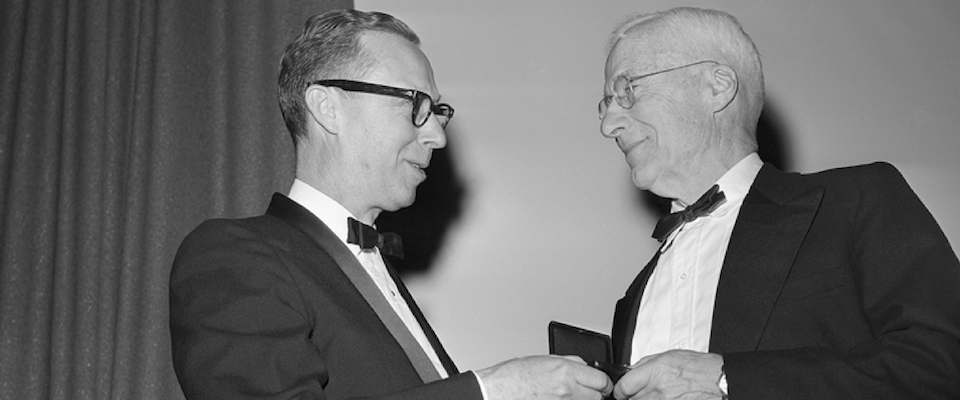Eureka! The Diving Bell and the Bullet Wound
On August 4, 1919, Berkeley chemist Joel H. Hildebrand (above, right) was shot and wounded by a lab assistant who accused the professor of opposing his application for appointment. Hildebrand survived—fortunately for the Navy. Twenty years later, in 1939, his work on the properties of gasses being dissolved into liquids saved the lives of 33 members of the USS Squalus when their submarine sank.
Hildebrand’s lifesaving discovery was a way to relieve a condition called the bends, or decompression sickness, known to cause effects ranging from joint pain to … well, death. As divers descend, nitrogen gas dissolves in the blood at high pressure and is then expelled too quickly as they surface. Like a bottle of soda being opened, the gas leaves in the form of bubbles which can have deadly consequences. Realizing that helium had a lower solubility in blood, Hildebrand posited that using it to dilute the breathing mixture could avoid the bends. Good news for the sailors on the Squalus, which sank to depths unreachable by air divers. Using a diving bell and helium/oxygen mixture, however, the crew was rescued.
Thanks to this and other discoveries by the chemist, he received nearly every major prize in chemistry for his contributions to the field, except the Nobel. Hildebrand Hall is named for him. And despite his angry assistant, he lived to be 101 years old.
Eureka! The Key to Life
When Dr. Wendell M. Stanley’s plane was grounded in Wyoming in 1946, he had no idea that his life was about to change. As it happened, a chat in the airport bar with University of California President Robert Gordon Sproul led to a job offer as head of Cal’s biochemistry department and a brand-new virus laboratory.

By that time, Stanley was already an expert in viruses, the ubiquitous infectious agents that, being neither quite living nor dead, are like the zombies of the microscopic world. In the 1930s, at Princeton, he had managed to crystalize the tobacco mosaic virus, the first pathogen ever to be identified as a virus. He later shared a Nobel Prize for his work on isolating viruses, which became a building block for the science of creating vaccines.
For Stanley, after whom Stanley Hall is named, viruses were more than just a personal fascination. “The viruses hold the key to the modification—for better or worse—of all life,” he said in 1956. “They hold the key to the secret of life, to the solution of the cancer problem, to biological evolution, to the understanding and control of heredity, perhaps to the nature of all future life on earth.”


















